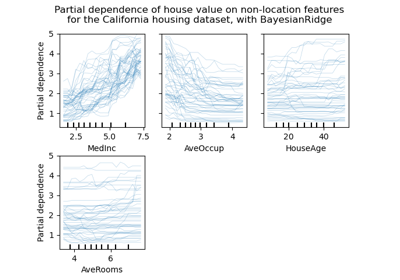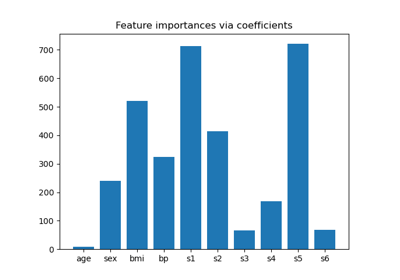sklearn.feature_selection.SequentialFeatureSelector¶
- class sklearn.feature_selection.SequentialFeatureSelector(estimator, *, n_features_to_select='warn', tol=None, direction='forward', scoring=None, cv=5, n_jobs=None)[source]¶
Transformer that performs Sequential Feature Selection.
This Sequential Feature Selector adds (forward selection) or removes (backward selection) features to form a feature subset in a greedy fashion. At each stage, this estimator chooses the best feature to add or remove based on the cross-validation score of an estimator. In the case of unsupervised learning, this Sequential Feature Selector looks only at the features (X), not the desired outputs (y).
Read more in the User Guide.
New in version 0.24.
- Parameters:
- estimatorestimator instance
An unfitted estimator.
- n_features_to_select“auto”, int or float, default=’warn’
If
"auto", the behaviour depends on thetolparameter:if
tolis notNone, then features are selected until the score improvement does not exceedtol.otherwise, half of the features are selected.
If integer, the parameter is the absolute number of features to select. If float between 0 and 1, it is the fraction of features to select.
New in version 1.1: The option
"auto"was added in version 1.1.Deprecated since version 1.1: The default changed from
Noneto"warn"in 1.1 and will become"auto"in 1.3.Noneand'warn'will be removed in 1.3. To keep the same behaviour asNone, setn_features_to_select="auto" and `tol=None.- tolfloat, default=None
If the score is not incremented by at least
tolbetween two consecutive feature additions or removals, stop adding or removing.tolis enabled only whenn_features_to_selectis"auto".New in version 1.1.
- direction{‘forward’, ‘backward’}, default=’forward’
Whether to perform forward selection or backward selection.
- scoringstr, callable, list/tuple or dict, default=None
A single str (see The scoring parameter: defining model evaluation rules) or a callable (see Defining your scoring strategy from metric functions) to evaluate the predictions on the test set.
NOTE that when using custom scorers, each scorer should return a single value. Metric functions returning a list/array of values can be wrapped into multiple scorers that return one value each.
If None, the estimator’s score method is used.
- cvint, cross-validation generator or an iterable, default=None
Determines the cross-validation splitting strategy. Possible inputs for cv are:
None, to use the default 5-fold cross validation,
integer, to specify the number of folds in a
(Stratified)KFold,An iterable yielding (train, test) splits as arrays of indices.
For integer/None inputs, if the estimator is a classifier and
yis either binary or multiclass,StratifiedKFoldis used. In all other cases,KFoldis used. These splitters are instantiated withshuffle=Falseso the splits will be the same across calls.Refer User Guide for the various cross-validation strategies that can be used here.
- n_jobsint, default=None
Number of jobs to run in parallel. When evaluating a new feature to add or remove, the cross-validation procedure is parallel over the folds.
Nonemeans 1 unless in ajoblib.parallel_backendcontext.-1means using all processors. See Glossary for more details.
- Attributes:
- n_features_in_int
Number of features seen during fit. Only defined if the underlying estimator exposes such an attribute when fit.
New in version 0.24.
- feature_names_in_ndarray of shape (
n_features_in_,) Names of features seen during fit. Defined only when
Xhas feature names that are all strings.New in version 1.0.
- n_features_to_select_int
The number of features that were selected.
- support_ndarray of shape (n_features,), dtype=bool
The mask of selected features.
See also
GenericUnivariateSelectUnivariate feature selector with configurable strategy.
RFERecursive feature elimination based on importance weights.
RFECVRecursive feature elimination based on importance weights, with automatic selection of the number of features.
SelectFromModelFeature selection based on thresholds of importance weights.
Examples
>>> from sklearn.feature_selection import SequentialFeatureSelector >>> from sklearn.neighbors import KNeighborsClassifier >>> from sklearn.datasets import load_iris >>> X, y = load_iris(return_X_y=True) >>> knn = KNeighborsClassifier(n_neighbors=3) >>> sfs = SequentialFeatureSelector(knn, n_features_to_select=3) >>> sfs.fit(X, y) SequentialFeatureSelector(estimator=KNeighborsClassifier(n_neighbors=3), n_features_to_select=3) >>> sfs.get_support() array([ True, False, True, True]) >>> sfs.transform(X).shape (150, 3)
Methods
fit(X[, y])Learn the features to select from X.
fit_transform(X[, y])Fit to data, then transform it.
get_feature_names_out([input_features])Mask feature names according to selected features.
get_params([deep])Get parameters for this estimator.
get_support([indices])Get a mask, or integer index, of the features selected.
Reverse the transformation operation.
set_params(**params)Set the parameters of this estimator.
transform(X)Reduce X to the selected features.
- fit(X, y=None)[source]¶
Learn the features to select from X.
- Parameters:
- Xarray-like of shape (n_samples, n_features)
Training vectors, where
n_samplesis the number of samples andn_featuresis the number of predictors.- yarray-like of shape (n_samples,), default=None
Target values. This parameter may be ignored for unsupervised learning.
- Returns:
- selfobject
Returns the instance itself.
- fit_transform(X, y=None, **fit_params)[source]¶
Fit to data, then transform it.
Fits transformer to
Xandywith optional parametersfit_paramsand returns a transformed version ofX.- Parameters:
- Xarray-like of shape (n_samples, n_features)
Input samples.
- yarray-like of shape (n_samples,) or (n_samples, n_outputs), default=None
Target values (None for unsupervised transformations).
- **fit_paramsdict
Additional fit parameters.
- Returns:
- X_newndarray array of shape (n_samples, n_features_new)
Transformed array.
- get_feature_names_out(input_features=None)[source]¶
Mask feature names according to selected features.
- Parameters:
- input_featuresarray-like of str or None, default=None
Input features.
If
input_featuresisNone, thenfeature_names_in_is used as feature names in. Iffeature_names_in_is not defined, then the following input feature names are generated:["x0", "x1", ..., "x(n_features_in_ - 1)"].If
input_featuresis an array-like, theninput_featuresmust matchfeature_names_in_iffeature_names_in_is defined.
- Returns:
- feature_names_outndarray of str objects
Transformed feature names.
- get_params(deep=True)[source]¶
Get parameters for this estimator.
- Parameters:
- deepbool, default=True
If True, will return the parameters for this estimator and contained subobjects that are estimators.
- Returns:
- paramsdict
Parameter names mapped to their values.
- get_support(indices=False)[source]¶
Get a mask, or integer index, of the features selected.
- Parameters:
- indicesbool, default=False
If True, the return value will be an array of integers, rather than a boolean mask.
- Returns:
- supportarray
An index that selects the retained features from a feature vector. If
indicesis False, this is a boolean array of shape [# input features], in which an element is True iff its corresponding feature is selected for retention. Ifindicesis True, this is an integer array of shape [# output features] whose values are indices into the input feature vector.
- inverse_transform(X)[source]¶
Reverse the transformation operation.
- Parameters:
- Xarray of shape [n_samples, n_selected_features]
The input samples.
- Returns:
- X_rarray of shape [n_samples, n_original_features]
Xwith columns of zeros inserted where features would have been removed bytransform.
- set_params(**params)[source]¶
Set the parameters of this estimator.
The method works on simple estimators as well as on nested objects (such as
Pipeline). The latter have parameters of the form<component>__<parameter>so that it’s possible to update each component of a nested object.- Parameters:
- **paramsdict
Estimator parameters.
- Returns:
- selfestimator instance
Estimator instance.


